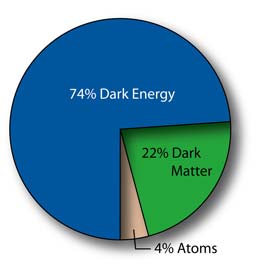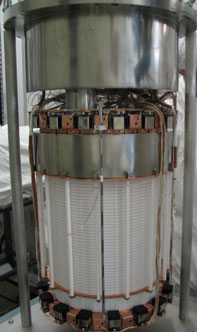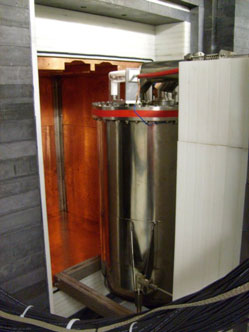
XENON
NEW - July 18, 2012 - XENON100 sets record limits for dark matter. Press release (Italian version) (English version)
Various astronomical observations have converged on a model of the Universe that is made up of 4% ordinary matter, 74% dark energy and 22% dark matter. Theoretical predictions suggest that this unknown mass could be made up of a generic class of particles called Weakly Interacting Massive Particles (WIMPs), relics of the Big Bang that exist still today. These WIMPs are believed to be a new form of matter that has not been observed yet.
However, based on observations of the rotation of galaxies, WIMPs are believed to exist in a spherically-symmetric distribution in the galaxy, making up a dark matter cloud through which the solar system, and hence the Earth, moves. Occasionally a WIMP would experience a collision with the atomic nuclei of an Earth-based detector while it is passing through the WIMP wind. This would lead to a detectable signal. Various direct detection experiments across the world adopt this principle to search for the dark matter particles. XENON is one of them.
Dark Matter Experiments
If the WIMP exists, it must have a very small interaction probability with "normal" matter -- otherwise it would have been already detected. Various theories, for example Supersymmetry (SUSY), also predict a tiny cross section for WIMP interaction. Any WIMP detector would therefore only see a few of these particles per year -- orders of magnitude less than the false signals that are always present in a detector and that are created by high energetic particles (that are created in the Earth's upper atmosphere) or by radioactivity in the vicinity of the detector. For this reason, all dark matter detectors are placed deep underground inside big and heavy shields made of lead/polyethylene or inside a water tank.
The interaction between a WIMP and a nucleus of a detector atom produces recoils of rather small energies (tens to hundred keVs). The recoil energy -- and with it the WIMP that deposited the energy -- may be measured by studying the scintillation light or the ionization signal (charge) produced in the detector medium or by measuring the tiny amount of heat deposited in the detector.
XENON
The XENON experiment is using liquid xenon as detector medium. (The noble gas xenon becomes liquid at a temperature of -100°C and a pressure of ~2 bar.) The high density (~3 g/cm3) and high atomic number (A~131) permits to construct compact detectors, where the outer part shields the inner part very efficiently. The simultaneous measurement of ionization and scintillation signals produced by particle interactions in liquid xenon allows to distinguish whether the particle was WIMP-like or a background signal.
Currently, the XENON collaboration is operating the XENON100 detector underground in the Gran Sasso Laboratory: it uses more than 100 kg of liquid xenon and is about 10 times bigger than its predecessor XENON10. XENON10 was installed at LNGS from 2005-2007, producing some of the best dark matter results so far.
In April 2011 we presented the results of about 100 days of XENON100 data. No hint of WIMP interaction was found, so we presented the currently best upper limit on the probability for this event to occur. The data taking with XENON100 is still ongoing in order to reach a higher sensitivity.
The next step foreseen by the XENON collaboration is to build XENON1T, a liquid xenon detector on the ton scale, installed inside a large water tank. It has been approved by the INFN council in April 2011: its construction will start in fall 2011 and its completion is expected in 2014.
 22% of the Universe consists of Dark Matter. |
 The XENON100 detector. |
 XENON100 installed in its shield at LNGS. |